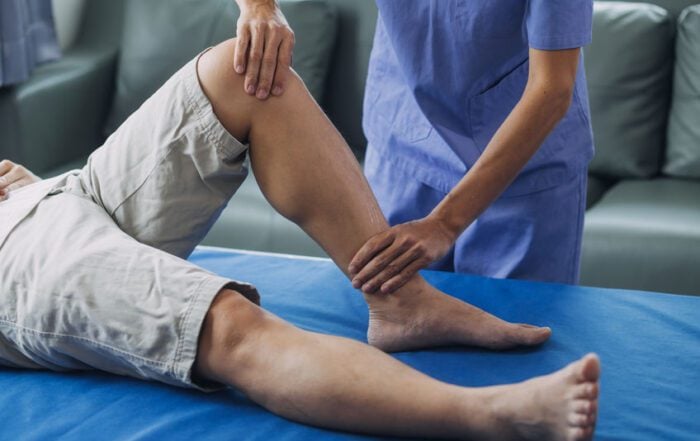One Ankle Sprain Too Many
Ankle sprains are relatively common, with an estimated 2 million injuries occurring in America every year. Sprains are even more common in athletes, with at least 40 -45% of all injuries ankle-related. A sprained ankle is a minor injury that happens when there is a twist, roll, or turn in an unconventional way. This stretch of the area can strain or tear the ligaments responsible for keeping the ankle in place. Constant sprains can cause long-term instability and, in some cases, require surgery.

Signs of chronic instability
Continuous sprains on the same foot can lead to chronic ankle instability, especially without proper recovery. Here are some common signs that may point to ankle instability:
- Chronic pain and stiffness in the area
- Continuous pain on the outer ankle
- Repeated sprains with minimal contact
- Swelling that may come and go based on the activity
Doctors can help determine instability by first looking at the patient’s medical history. Other physical exams or x-rays of the ankle can reveal swelling and tenderness. These examinations would provide insight and help determine ways to stabilize the joint.
Keep walking with non-surgical options
There are ways to repair the ankle of minor issues before going under the knife. First, doctors may recommend physical therapy, which involves exercises that improve balance or retrain the injured muscle. For athletes, this may include specific techniques that will help with the particular sport. Bracing is another method as this allows the ankle to rest and relieves tension to aid in recovery. Lastly, help is available in the form of nonsteroidal anti-inflammatory drugs (NSAIDs), like ibuprofen. Over time, one or more of these methods can help prevent chronically unstable ankles.
Turning to stabilization surgery
Surgery for ankle sprains is only recommended if non-surgical options fail if the ligament damage is severe. There are 2 main categories surgeons will consider, namely anatomic ligament repair or non-anatomic ankle ligament reconstruction. The latter usually is reserved for more extensive damage. A stabilization operation involves the repair and rebuilding of the damaged ligaments. First, a small cut is made over the torn ligaments of the lateral (outer) ankle. Then, the worn or torn ligaments are repaired with appropriate tension to restore function.
Stronger together
There are some instances where the 2 surgeries can combine to achieve better results. For example, there could be a severely damaged ligament causing frequent sprains and instability. The surgeon will look to reconstruct the anterior talofibular ligament (ATFL) or the calcaneofibular ligament (CFL). Patients have a high success rate for these surgical methods thanks to minimally invasive means.
Preventing another sprain with proper care
After the surgery, the ankle goes into a splint. Surgeons recommend placing little to no weight on the leg. The splint is upgraded to a removable boot, and after the second week, the road to recovery begins. Physical therapy takes place a few weeks after surgery. Patients typically recover between 4-5 months at a minimum and return to daily activities with little to no pain. Physical therapy, warm-ups, and strengthening exercises well beyond recovery can prevent another instability diagnosis.
Get stability in your life
Contact a doctor if the pain, swelling, or any other symptoms continue after repeated sprains. More importantly, if sprains are happening easily, there could be a sign of instability. For chronic ankle instability, there are non-surgical options available. However, if all else fails, surgical methods like stabilization surgery can have patients walking in no time.
Recent Posts
ACL Repair: Will You Have Range Of Motion With Your Knee After Recovery & Physical Therapy?
After an ACL injury, ROM can be negatively affected. ACL repair surgery helps restore function, but physical therapy is essential to ROM.
Arthroscopy: What Are The Benefits Of This Minimally Invasive Outpatient Orthopedic Procedure?
Arthroscopy can help diagnose or treat joint conditions. Benefits of the MIS include faster recovery, less pain, and fewer scars.
Posterior Interbody Lumbar Fusion: What Are The Benefits Of PLIF For People With Back Pain?
People with chronic back pain may benefit from posterior interbody lumbar fusion surgery. PLIF can reduce pain and improve stability.
Saying Goodbye To Tonsil Troubles: The Benefits Of Minimally Invasive Tonsillectomy
Chronic tonsilitis or other tonsil troubles can impact health and well-being. A minimally invasive tonsillectomy can reduce infections.
“I liked that it was so clean. Every staff member was pleasant and easy to talk with.”
“NO wait time, RN Rebecca answered all questions prior to my visit by phone and again answered all questions and concerns while prepping me.”
“Amazing nurses, very caring and friendly and put both me and my son at ease.”
“Everyone was friendly and concerned about my comfort. They frequently asked how I was doing, or if I needed something.”
“Everyone was friendly and the place was very clean.”
“Entire staff was knowledgeable and courteous. They genuinely cared for my well being and made sure my wife and I were taken care of.”
“The staff was great, especially Mary and Marcia. Marcia was extremely helpful post-op and made sure I was comfortable and well-cared for.”
“The STAFF from the moment you walk in were the nicest people I’ve encountered at a medical facility.”
“All staff were wonderful.”
“Efficiency of the staff. Courteous, friendly and caring attitude. Excellent office staff. Pleasant surroundings.”
“Dr. Dedhia made everything clear and even scheduled an early follow-up appt so I could get back to work sooner.”
“Everyone was friendly and the place was very clean.”
“The STAFF from the moment you walk in were the nicest people I’ve encountered at a medical facility.”
“Anesthesia staff was outstanding!”
“Incredibly professional, friendly and confidence of knowing their roles as healthcare employees. Excellent!”
“Incredibly professional, friendly and confidence of knowing their roles as healthcare employees. Excellent!”
“Amazing nurses, very caring and friendly and put both me and my son at ease.”
“Efficiency of the staff. Courteous, friendly and caring attitude. Excellent office staff. Pleasant surroundings.”
“Everyone was friendly and concerned about my comfort. They frequently asked how I was doing, or if I needed something.”
“Experience was amazing. The nurses my son needed at this time couldn’t have been chosen any more perfect. They were supportive and understanding, patient and just great human beings.THANK YOU KINDLY ”
“Rebecca was amazing. I have always had trouble in the past with getting an IV started. I told Rebecca I was concerned about it. She got it on the 1st try – no digging in my arm and NO bruising the next day.”
“The staff was great, especially Mary and Marcia. Marcia was extremely helpful post-op and made sure I was comfortable and well-cared for.”
“No severe pain – Just a little discomfort – I was asked several times during procedure if I was OK – they showed genuine concern for my well being.”
“Anesthesia staff was outstanding!”
“The staff was very polite, they were excellent. They explained exactly what was going on.”
“I can’t say enough about Marcia and the entire team. The care I received was well beyond anything I could have expected.”
“Entire staff was knowledgeable and courteous. They genuinely cared for my well being and made sure my wife and I were taken care of.”
“Dr. Best…is the best!”
“Rebecca was amazing. I have always had trouble in the past with getting an IV started. I told Rebecca I was concerned about it. She got it on the 1st try – no digging in my arm and NO bruising the next day.”
“The nurses were very nice and caring!”
“NO wait time, RN Rebecca answered all questions prior to my visit by phone and again answered all questions and concerns while prepping me.”
“Marcia and staff were excellent and genuinely cared for my well being. Wish I could have taken them home.”
“Marcia and staff were excellent and genuinely cared for my well being. Wish I could have taken them home.”
“Dr. Tupper was amazing! He spent time explaining exactly what he was doing, what I would experience and made sure I was comfortable.”
“I liked that it was so clean. Every staff member was pleasant and easy to talk with.”
“Everyone was concerned with my comfort.”
“The nurses were very nice and caring!”
“No severe pain – Just a little discomfort – I was asked several times during procedure if I was OK – they showed genuine concern for my well being.”
“Experience was amazing. The nurses my son needed at this time couldn’t have been chosen any more perfect. They were supportive and understanding, patient and just great human beings.THANK YOU KINDLY ”
“Dr. Tupper was amazing! He spent time explaining exactly what he was doing, what I would experience and made sure I was comfortable.”
“I can’t say enough about Marcia and the entire team. The care I received was well beyond anything I could have expected.”
“Dr. Best…is the best!”
“All staff were wonderful.”
“Dr. Dedhia made everything clear and even scheduled an early follow-up appt so I could get back to work sooner.”
“Everyone was concerned with my comfort.”
“The staff was very polite, they were excellent. They explained exactly what was going on.”
Recent Posts
ACL Repair: Will You Have Range Of Motion With Your Knee After Recovery & Physical Therapy?
After an ACL injury, ROM can be negatively affected. ACL repair surgery helps restore function, but physical therapy is essential to ROM.
Arthroscopy: What Are The Benefits Of This Minimally Invasive Outpatient Orthopedic Procedure?
Arthroscopy can help diagnose or treat joint conditions. Benefits of the MIS include faster recovery, less pain, and fewer scars.
Posterior Interbody Lumbar Fusion: What Are The Benefits Of PLIF For People With Back Pain?
People with chronic back pain may benefit from posterior interbody lumbar fusion surgery. PLIF can reduce pain and improve stability.
Saying Goodbye To Tonsil Troubles: The Benefits Of Minimally Invasive Tonsillectomy
Chronic tonsilitis or other tonsil troubles can impact health and well-being. A minimally invasive tonsillectomy can reduce infections.








